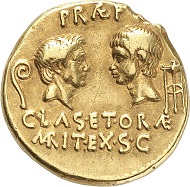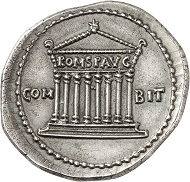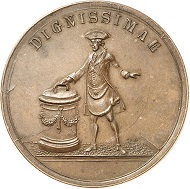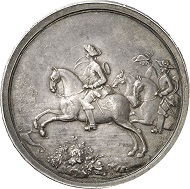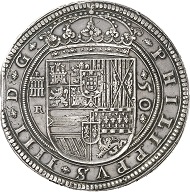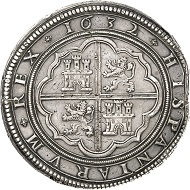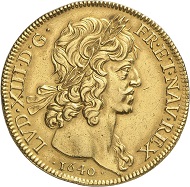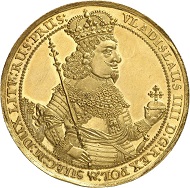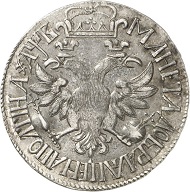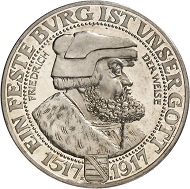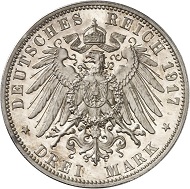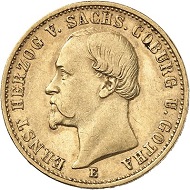13-03-2016 – 17-03-2016
Auction 273-276
Künker March-Auction 273-276: Take care of the penny…
This spring Künker will be presenting four catalogs. From antiquity to the Federal Republic of Germany, there will be coins and medals from Germany (including a special collection Münster), from Europe (with large sections of Carolingian coins, as well as Danish and British medieval coins), from Russia and overseas. For many the highlight will take place on the last day of auction: when Künker auctions off the Lorenz Collection, a special collection of minor denominations rarities and patters from post-1871 Germany. Not to forget silver and gold, this auction catalog offers all the great rarities of the German Empire in spectacular quality.
Lot 127: CATANE (Sicily). Tetradrachm, around 460. Ex Sternberg Auction 20 (1988), 254. Very rare. Extremely fine. Estimate: 50,000,- euros.
Auction 273: Antiquity
The auction will kick off with 60 Celtic and 440 Greek coins. And the connoisseur will certainly note many rarities: For example, a selection of Bavarian rainbow cups or the two tetradrachms from Katane: the first is an archaic piece displaying the river god in disguise as a bull (127, EF, Estimate: 50,000 euros) and the second is a classic piece presenting the portrait of Apollo made by Herakleides, perhaps the most beautiful coin of all time (129, EF-VF, Estimate: 50,000 euros).
There are many interesting coins among the ancient Greek coins: For example, a dekadrachm from Syracuse, a golden distater of Alexander, or an electron stater from Cyzicus displaying both eagles meeting above the omphalos, after they flew around the globe. The Egyptian department offers a rich selection of gold coins.
Lot 566: SEXTUS POMPEY, + 35 BC. Aureus, 37/36 BC, Sicilian mint. Ex Feuardent Collection, Bourgey Auction (2009), 23. Very rare. Very fine. Estimate: 75,000,- euros.
Collectors of Roman coins should take a good look at the catalog. There are many Roman Republican pieces. Historically highly important is an aureus of great rarity issued by Sextus Pompey showing his portrait on the obverse and the portrait of his father and brother on the reverse (566, VF, estimate: 75,000 euros).
The department of the Roman Empire also offers plenty of aurei. Caligula with Augustus, Titus, Domitian with Domitia, Marcus Aurelius, the youthful Caracalla with Septimius Severus and Iulia Domna, Herennia Etruscilla as well as Priscus Attalus – and these are only a few examples. The rarest piece is an aureus of Postumus, which displays his and Hercules’ double portrait. On the reverse it shows the busts of Victoria and Felicitas (901, plugged hole, EF, estimate: 75,000 euros).
Nr. 742 – Lot 742: HADRIAN, 117-138. Cistophorus, 128-138, Nicomedia. Ex Leu Auction 18 (1977), 330 (cover piece). Rare. Extremely fine. Estimate: 5,000,- euros.
There are, of course, also extremely well preserved silver and bronze specimen with exquisite patinas. Such as the title piece of the auction. A cistophorus of Hadrian with the temple of Roma and Augustus on the reverse (742, EF, estimate: 5,000 euros).
Even longstanding collectors will be in awe considering the extensive selection of medallions for sale. Let us tell you about two specimens: an extremely rare bi-metallic bronze medallion displaying the arrival of the “wheat fleet” in the harbor of Ostia (811, VF, estimate: 5,000 euros) and a 324 gold medallion in the weight of one and a half solidi of Constantine the Great minted in Nicomedia (938, VF, estimate: 10,000 euros).
Last but not least, there will be strikings of the great migration, of the Byzantine Empire, of the Crusaders and the Near and Far East.
Lot 1644: BRANDENBURG-BAYREUTH. Frederick, 1735-1763. Bronze freemasonry medal 1759 (5759), unsigned, of the Lodge of the Sun in Bayreuth on his second marriage to Sophie Caroline Marie. Very rare. Extremely fine. Estimate: 150,- euros.
Auction 274: Medieval and modern coins and medals / Coin scales and weights collection
The fact that coins with great historical meaning don’t have to be expensive can be proven by a 5759 free mason medal. 5759? Yes, you did read that right, because the free masons started their calendar with the year of light in 4000 B.C., thus postulating when the world was created. The year 5759 equals 1759 of our calendar. The medal, which motifs allude to the secrets of the free masons, can be found in Künker catalog 274 under number 1644. Extremely fine in its preservation, the medal is estimated at 150 euros.
Among the pre-1871 German coins you will also find more expensive pieces. Just look at the great selection of lösers from the duchies of Brunswick. The most pricy piece is estimated at 7,500 euros. It’s a 1647 triple reichstaler from Friedrich of Bruswick-Lüneburg-Celle from Clausthal. The reverse displays two embracing miners in front of a shaft, which represents the widespread desire for freedom at the time.
Lot 1968: HESSE-DARMSTADT. Louis VIII, 1739-1768. Jagdthaler 1751, by A. Schäfer. Ex Mercator Coll., Künker Auction 220 (2012), 7755. Very rare. Extremely fine. Estimate: 10,000,- euros.
An historic and distinguished document for the baroque court ceremonies can be found in two talers of Louis VIII of Hesse-Darmstadt. They show scenes of royal hunting parties with impressive animal imagery. At his time, Louis was an avid devotee of the hunting sport, and for rewarding his hunters he had these so-called stag and hunting talers produced.
The first catalog is finally concluded by a Münster special collection, including many rarities, a large selection of rare Saxon coins, and, finally, an extensive collection of German and world coin scales.
World coins are following this section. Collectors of medieval coins will study these pages of the catalog with intensity. There are almost 50 Carolingian coins, about 70 strikings from the Danish Viking-period, and last but not least, almost 150 early pennies from Great Britain and Ireland.
Lot 3425: SPAIN. Felipe IV, 1621-1665. Cincuentin (50 reales) 1632, Segovia. Only 10 specimens struck. Very fine to extremely fine. Estimate: 30,000,- euros.
Of course, as always, the modern department offers the accustomed quality. For example, we can present to you a 1632 cincuentin, minted in Segovia, in a spectacular condition.
Auction 275: Gold strikings / Russian coins and medals
On Wednesday afternoon Auction 275 will start with world gold coins and medals. In particular, the French-Belgian region will be a focus. The selection on offer ranges from a gorgeous heaume d’or of Louis of Male to a Merovingian coin of the Abby of Saint-Maurice located in the Valais …
Lot 4055: FRANCE. Louis XIII, 1610-1643. Huit louis d’or à la tete laurée 1640, Paris. Extremely rare. Very fine to extremely fine. Estimate: 100,000,- euros.
… and an octuple Louis d’or from 1640. But there are also many other interesting varieties of the ‘normal’ Louis d’ors. Let’s take, for example, the year 1786: From this particular year Künker offers single and double Louis d’ors from Paris, Bordeaux, Limoges, Nantes, and Lille.
Aficionados of British gold coins should also study the catalog thoroughly. They will find many rare 5 guineas-pieces, but also a series of 1/2 and 1/3 guineas and sovereigns in extraordinary preservation.
Lot 4386: POLAND. Danzig, city. 8 ducats 1644, with title of Wladyslaw IV (1632-1648). Extremely rare. Nearly FDC. Estimate: 150,000,- euros.
The title piece, which is also the piece going over the auction block with the highest estimate of 150,000 euros, derives from Gdansk. It’s an 1644 8 ducat displaying the title and the portrait of Vladislaus IV and on its reverse a magnificent view of the city of Gdansk.
Estimates in the area of pre-1871 German coins don’t quite reach as high, but you can find many outstanding rarities, mainly stemming from the Vogel Collection. Among them, for example, an 1855 Bavarian ducat, a later striking from the yield of Goldkronach, estimated at 50,000 euros, a gold off-metal strike of 10 ducats made from the dies of the Bremen taler of 1864 on the opening of the new bourse estimated at 20,000 euros, and another gold off-metal strike of 20 ducats made from the dies of an 1871 double vereinstaler from Württemberg, estimated at 30,000 euros. From an extensive collection of coins from Münster (also refer to Auction 274), comes a sextuple ducat of Christoph Bernhard of Galen on the 1661 capture of Münster, estimated at 20,000 euros. And finally, there is a truly spectacular unique rarity: a late gold off-metal strike of the so-called butterfly taler in the weight of 11 ducats, estimated at 25,000 euros.
Lot 4934: RUSSIA. Peter I the Great, 1682-1725. 1/2 roubel (poltina) 1702 (Cyrillic), Moscow, Kadashevsky Mint. Ex Lisenko Collection. Very rare. Good extremely fine. Estimate: 25,000,- euros.
The section will be followed by almost 400 Russian coins, containing many rarities. For example a 1718 2 ruble piece of the Red Mint of Moscow (4931, VF-EF, estimate: 10,000 euros), a poltina displaying the date 1720 in Cyrillic struck in the Kadashevsky mint in Moscow (4934, EF+, estimate: 25,000 euros) and a 1766 10 rubel piece in gold from St. Petersburg (4999, almost EF, estimate: 10,000 euros). Minor denominations are also plentiful and hold unexpected treasures. The connoisseur will find an 1840 copper novodel of half a kopek emitted in Yekaterinburg. This very rare piece not only comes in an extremely fine to brilliant uncirculated condition and a beautiful patina, but also with the expertise of Igor Schiryakov of the State Museum Moscow (Estimate: 1,500 euros).
Lot 5747: GERMAN EMPIRE. Saxony. Frederick August III, 1904-1918. 3 mark 1917 E. Frederick the Wise. Proof. Estimate: 60,000,- euros.
Auction 276: German post-1871 coins featuring the Lorenz Collection
It is much harder to find minor denominations in an excellent condition, than silver high-denomination pieces or even gold coins. It’s in the nature of things. One doesn’t usually pay with a 500 euro note nowadays either. But that doesn’t mean the notes are rare – they are simply horded and treated with care, just as it was done with 20 mark coins of the German Empire.
The small pfennnigs though, changed hands continuously. For one pfennig you could get an egg in 1880. And that was real money when you keep in mind that a butcher’s assistant made 5 marks laboring for 72 hours a week.
Lot 5517: GERMAN EMPIRE. 20 pfennig 1887 E. Only 50 specimens struck. Nearly FDC. Estimate: 5,000,- euros.
All this, one should know in order to appreciate the quality of the Lorenz Collection. Considering, that there are about 50 preserved specimens of the Frederick the Wise silver coin, one can guess the level of rarity for an 1887 1 pfennig piece of which only 25 were minted. In the upcoming Künker sale, by the way, you will be able to bid on a Friedrich the Wise in proof, too. The piece is estimated at 60,000 euros. But back to the 1 pfennig piece. The item in question is literally the last pfennig of the Dresden mint, before it was moved to Muldenhütten (estimate: 10,000 euros). There is also an 1887 20 pfennig piece of the Muldenhütten mint, of which only 50 pieces were produced. In our auction it is appraised at 5,000 euros. Because the 1905 E pfennigs from Muldenhütten were only minted during Frederick Augustus III’s visit to the mint, only a handful still exists. Our specimen for sale is estimate at 10,000 euros.
But not all pieces are priced quite so highly. For example, a 1910 E 25 pfennig piece in proof condition is appraised at 150 euros.
Lot 6187: GERMAN EMPIRE. Saxe-Coburg-Gotha. Ernest II, 1844-1893. 20 mark 1872. Very fine to extremely fine. Estimate: 60,000,- euros.
Also the silver and gold of the German Empire offers many rarities. We already mentioned the popular Frederick the Wise. And the rarest gold type of the German Empire is to be found either: an 1872 20 mark piece with the portrait of Ernst II of Saxony-Coburg-Gotha.
The Lorenz Collection of patterns contains more than 200 pieces. Among them are many rarities, some of them are neither mentioned in the Beckenbauer nor in the Schaaf Collection. As common with patterns, their preservation is consistently better than extremely fine. Let us take a closer look at two pieces: A 1947 A 10 reichspfennig pattern, displaying a Slavic 7 (with a slash) and a 2 mark piece from 1950 with a deepened legend and devaluated through a punching.
You can order the catalogs at Künker, Nobbenburgerstr. 4a, 49076 Osnabrück; Tel: + 49 541 96202 0; Fax: + 49 541 96202 22; or email.
Please also find all pieces up for auction online here.








